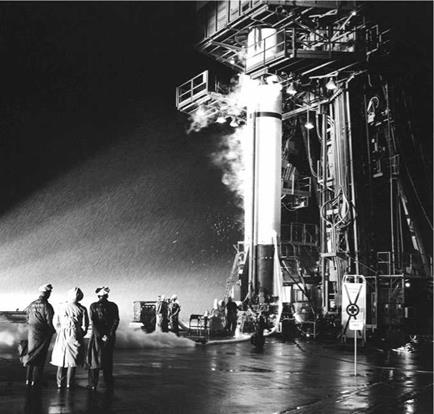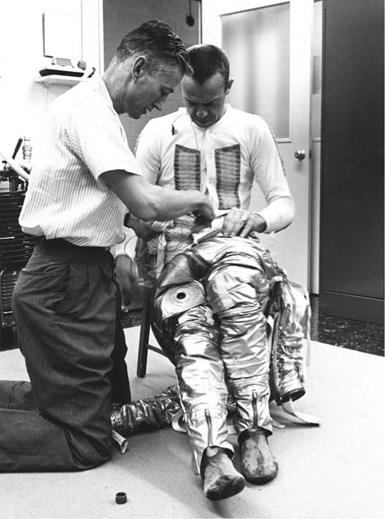Countdown to launch
At 12:30 a. m. on 2 May 1961 the countdown for MR-3 began, but the prospects of a launch were never very good. In spite of being late spring, violent thunderstorms had rumbled over the Cape that evening; it was raining heavily and occasional lightning flashes danced up and down the Florida coastline. Lining the beaches were people determined to see the launch, shivering under raincoats and ponchos, praying for the filthy weather to clear. The loading of liquid oxygen into the Redstone went ahead, but as the minutes ticked by the odds against flying steadily increased.
THUNDER OVER THE CAPE
Following the unexpected orbital mission of Yuri Gagarin and the nation’s growing eagerness for an American to be launched into space, NASA had decided that as they were a civilian space agency and Mercury was an open program – unlike that of the Soviet Union – they would permit each flight to be televised live. On being assured about the abort system’s capabilities, the thoroughness of the training, the readiness of the astronaut, and the integrity of the hardware involved, President Kennedy had agreed that the world should see the launch live. Nevertheless, he and his advisors remained concerned about a catastrophe in which the astronaut was lost as the world looked on. The television coverage was scheduled to commence at T-2 minutes and, around the nation, families settled in front of their television sets in a state of nervous excitement.
As arranged, flight surgeon Bill Douglas stole into crew quarters at 1:00 a. m. and gently roused the sleeping astronaut along with his backup, John Glenn. In response to Shepard’s mumbled query, Douglas informed him the weather was quite bad at the moment, but a decision had been made to begin fueling the rocket. They were to proceed with the medical examination and suiting-up in the hope the weather would clear. After a shower and shave, Shepard donned his dressing gown and then joined Grissom and Glenn for an early morning high-protein breakfast of orange juice, filet mignon wrapped in bacon, and scrambled eggs, although the others opted instead for poached eggs.
C. Burgess, Freedom 7: The Historic Flight of Alan B. Shepard, Jr., Springer Praxis Books, DOI 10.1007/978-3-319-01156-1_4, © Springer International Publishing Switzerland 2014
Then, ready to face whatever lay in store for him that morning, it was time to undergo the pre-flight physical and psychiatric examinations.
Medical tests established that Shepard was still in the same perfect health he had previously enjoyed; his eyesight was normal, there were no respiratory ailments, his ear canals were clear, his thyroid was smooth and without any tenderness, his heart rhythm was regular and his blood pressure gave no discernible hint of the challenges he might soon face.
Then a lengthy interview with the NASA psychiatrist confirmed the astronaut’s mental preparedness. The psychiatrist’s report stated, in part, that Shepard “appeared relaxed and cheerful. He was alert and had abundant energy and enthusiasm. [His manner] was appropriate. He discussed potential hazards of the flight realistically and expressed slight apprehension concerning them. However, he dealt with such feelings by repetitive consideration of how each possible eventuality could be managed. Thinking was almost totally directed to the flight. No disturbances in thought or intellectual functions were observed.” [1]
The next phase of the pre-launch operations for Shepard entailed having an array of medical sensors attached to his body. Clad only in the bottom half of his specially padded and ventilated long-johns, he stood patiently while the doctors positioned the
|
Conditions at the Cape on 2 May 1961 were never conducive for a launch. (Photo: NASA) |
six sensors which would monitor and transmit his physiological state to the Mission Control Center. In this procedure, doctors glued a non-conducting cup containing a non-irritating paste to his skin, and used this paste as the lead-off from the skin. A shielded wire attached to a stainless steel mesh was buried within the paste, but not touching the skin. Four of these sensors went in predetermined spots under the right armpit, on the upper and lower chest, and on the lower left side of his body. Another was inserted into Shepard’s rectum to record his anal temperature, and the last went below the nostrils to monitor his respiration. The six sensor wires were then bunched together in the common terminal that would later be plugged into a socket located adjacent to his right knee in the spacecraft.
|
Suit technician Joe Schmitt adjusts the sensor wire socket incorporated into the leg of Shepard’s suit. (Photo: NASA) |
Next, Shepard made his way into the dressing room where NASA suit technician Joe Schmitt was waiting to assist in the awkward procedure of donning his $10,000 pressure suit and helmet. The first item of clothing was long cotton underwear with ribbed sections on the arms, legs, and back to facilitate the circulation of air. Next came the custom-made, 20-pound silvery space suit itself, which was comprised of an inner layer of rubber and an outer layer of aluminized nylon. The suit was sealed by means of airtight zippers, laces, and straps, and encircling the neck area was a soft rubber cone that would make the suit waterproof when the helmet had been removed for egress. Although the suit was inflatable, this safeguarding measure would only be taken if there was a loss of air pressure inside the capsule, and it would allow the astronaut 90 valuable minutes of protection. Once inflated, the suit became almost rigid, although the gloves were designed with curved fingers to allow the astronaut to grip the controls, albeit with the exception of a single finger on the left glove, which remained straight for the purpose of pushing buttons.
Shepard took a seat, and after both legs of the suit had been inserted one at a time, the bundled sensor wires were carefully threaded through a hole in the thigh area. He then stood up and slipped his arms one at a time into the sleeves of the suit, which was zippered across his chest and middle. After pulling boots over his white socks and securing them, Shepard pulled on his gloves and zipped them to each sleeve. He also slipped on a pair of plastic overshoes which he would remove prior to insertion into the spacecraft. These were to prevent dirt picked up on the way to the hatch of Freedom 7 from entering the capsule. Finally, Joe Schmitt lowered Shepard’s helmet over his head, securing it in place with a ring lock.
An air tightness test was then conducted on the space suit. To accomplish this, Shepard reclined in a contour couch and closed his helmet’s faceplate. Schmitt then inflated the suit to 5 psi and checked it for leaks. Finding none, the suit was deflated again and a portable air-conditioning unit was connected to the suit. Shepard would carry this in his hand from that moment until he was ready to plug himself into the spacecraft’s air-conditioning system.
The preparations complete, Shepard then sat in Hangar S awaiting the go/no-go decision, his suit cooled by the air-conditioning unit.
“The signs were not propitious,” he later explained. “And at 3:30 a. m., with the liquid oxygen already loaded aboard the booster, the technicians took a look at the lightning and declared a ‘hold.’ They started working again at 3:50, with the count at T minus 290 minutes.” [2]












